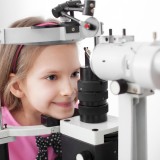How Socioeconomic Status Can Impact Kids’ Eye Health
Research is showing that insurance isn’t the only key factor in whether or not children are getting proper eye care. The University of Michigan conducted a study that examines the relationship between kids’ eye health and the socioeconomic status of their families. It shows that children from less affluent homes are less likely to be diagnosed with dangerous eye conditions before they permanently impact vision.
University of Michigan Study
Researchers looked at commercial health insurance data for almost 900,000 children up to age 14. Based on insurance claims, the study examined the frequency of optometrist and ophthalmologist visits between 2001 and 2014, along with the rates of diagnosis for amblyopia (lazy eye) and strabismus (crossed eyes).
Importance of Early Diagnosis
These conditions are important to diagnose early, as they can pose serious risks. With these conditions, each eye sees differently. This causes the brain to suppress vision in one eye. Research shows that permanent vision loss can result if the conditions aren’t corrected by the time kids are 10 years old.
Socioeconomic Status and Diagnosis Rates
The study, which was published in the August 2016 issue of Health Affairs, shows that kids in families of the lowest net worth bracket (under $25,000 per year) visited an eye care professional 16% less frequently than kids who were in the middle-income group of $150,000 to $250,000 per year. Furthermore, kids in the highest bracket (more than $500,000) visited the eye doctor 19% more than the middle-income category.
Missed Eye Health Opportunities
As one can assume, eye care visits are strongly correlated to diagnosis of abnormal eye conditions, a result which this study confirmed. Overall, researchers estimate that roughly 12,800 lower-income children didn’t receive a needed strabismus diagnosis. Likewise for amblyopia cases, in which an estimated 5,400 cases went undiagnosed.
Theories for the Discrepancy
So if these families all have insurance, what’s causing the differences? Experts suggest that lower-income families face more obstacles than their more affluent counterparts. For example, lower-income parents and guardians may have transportation issues to and from the eye care office, in addition to potential issues taking time off work to take their children. Eye care providers may also be sparser in lower-income neighborhoods.
Regular Visits, Better Outcomes
The importance of regular eye care visits are often overlooked by individuals and families across all levels on the socioeconomic spectrum. When possible, we urge our readers to place special attention on making sure that their children are growing healthily and safely, with confirmation from a professional.

















